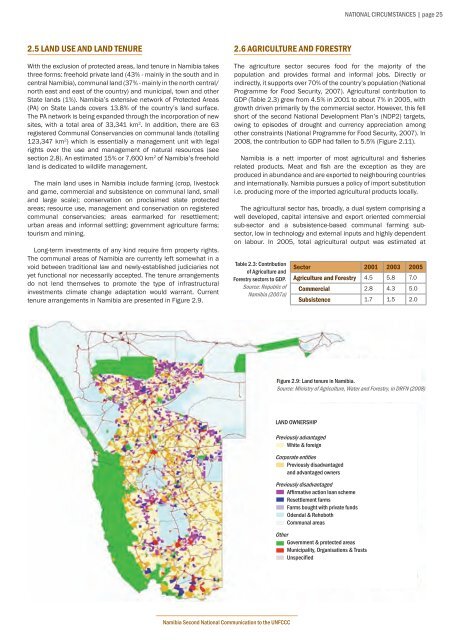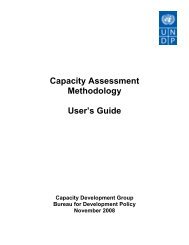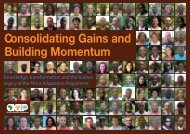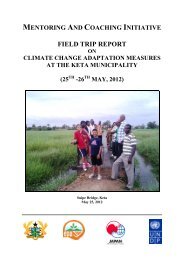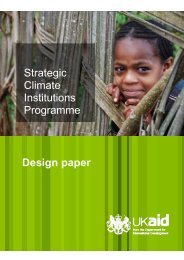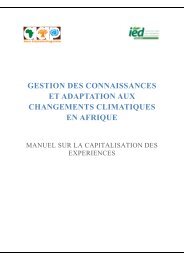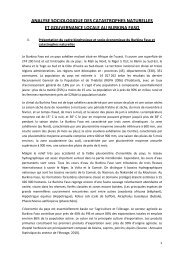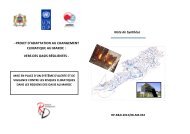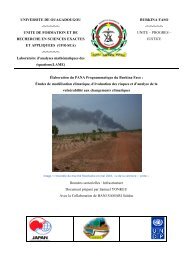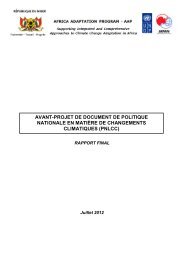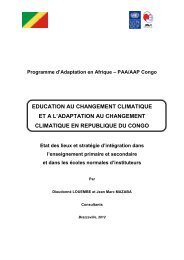Namibia Second National Communication to UNFCCC 2011.pdf
Namibia Second National Communication to UNFCCC 2011.pdf
Namibia Second National Communication to UNFCCC 2011.pdf
Create successful ePaper yourself
Turn your PDF publications into a flip-book with our unique Google optimized e-Paper software.
NATIONAL CIRCUMSTANCES | page 252.5 LAND USE AND LAND TENUREWith the exclusion of protected areas, land tenure in <strong>Namibia</strong> takesthree forms: freehold private land (43% - mainly in the south and incentral <strong>Namibia</strong>), communal land (37% - mainly in the north central/north east and east of the country) and municipal, <strong>to</strong>wn and otherState lands (1%). <strong>Namibia</strong>’s extensive network of Protected Areas(PA) on State Lands covers 13.8% of the country’s land surface.The PA network is being expanded through the incorporation of newsites, with a <strong>to</strong>tal area of 33,341 km 2 . In addition, there are 63registered Communal Conservancies on communal lands (<strong>to</strong>talling123,347 km 2 ) which is essentially a management unit with legalrights over the use and management of natural resources (seesection 2.8). An estimated 15% or 7,600 km 2 of <strong>Namibia</strong>’s freeholdland is dedicated <strong>to</strong> wildlife management.The main land uses in <strong>Namibia</strong> include farming (crop, lives<strong>to</strong>ckand game, commercial and subsistence on communal land, smalland large scale); conservation on proclaimed state protectedareas; resource use, management and conservation on registeredcommunal conservancies; areas earmarked for resettlement;urban areas and informal settling; government agriculture farms;<strong>to</strong>urism and mining.Long-term investments of any kind require firm property rights.The communal areas of <strong>Namibia</strong> are currently left somewhat in avoid between traditional law and newly-established judiciaries notyet functional nor necessarily accepted. The tenure arrangementsdo not lend themselves <strong>to</strong> promote the type of infrastructuralinvestments climate change adaptation would warrant. Currenttenure arrangements in <strong>Namibia</strong> are presented in Figure 2.9.2.6 AGRICULTURE AND FORESTRYThe agriculture sec<strong>to</strong>r secures food for the majority of thepopulation and provides formal and informal jobs. Directly orindirectly, it supports over 70% of the country’s population (<strong>National</strong>Programme for Food Security, 2007). Agricultural contribution <strong>to</strong>GDP (Table 2.3) grew from 4.5% in 2001 <strong>to</strong> about 7% in 2005, withgrowth driven primarily by the commercial sec<strong>to</strong>r. However, this fellshort of the second <strong>National</strong> Development Plan’s (NDP2) targets,owing <strong>to</strong> episodes of drought and currency appreciation amongother constraints (<strong>National</strong> Programme for Food Security, 2007). In2008, the contribution <strong>to</strong> GDP had fallen <strong>to</strong> 5.5% (Figure 2.11).<strong>Namibia</strong> is a nett importer of most agricultural and fisheriesrelated products. Meat and fish are the exception as they areproduced in abundance and are exported <strong>to</strong> neighbouring countriesand internationally. <strong>Namibia</strong> pursues a policy of import substitutioni.e. producing more of the imported agricultural products locally.The agricultural sec<strong>to</strong>r has, broadly, a dual system comprising awell developed, capital intensive and export oriented commercialsub-sec<strong>to</strong>r and a subsistence-based communal farming subsec<strong>to</strong>r,low in technology and external inputs and highly dependen<strong>to</strong>n labour. In 2005, <strong>to</strong>tal agricultural output was estimated atTable 2.3: Contributionof Agriculture andForestry sec<strong>to</strong>rs <strong>to</strong> GDP.Source: Republic of<strong>Namibia</strong> (2007a)Sec<strong>to</strong>r 2001 2003 2005Agriculture and Forestry 4.5 5.8 7.0Commercial 2.8 4.3 5.0Subsistence 1.7 1.5 2.0Figure 2.9: Land tenure in <strong>Namibia</strong>.Source: Ministry of Agriculture, Water and Forestry, in DRFN (2008)LAND OWNERSHIPPreviously advantagedWhite & foreignCorporate entitiesPreviously disadvantagedand advantaged ownersPreviously disadvantagedAffirmative action loan schemeResettlement farmsFarms bought with private fundsOdendal & RehobothCommunal areasOtherGovernment & protected areasMunicipality, Organisations & TrustsUnspecified<strong>Namibia</strong> <strong>Second</strong> <strong>National</strong> <strong>Communication</strong> <strong>to</strong> the <strong>UNFCCC</strong>


